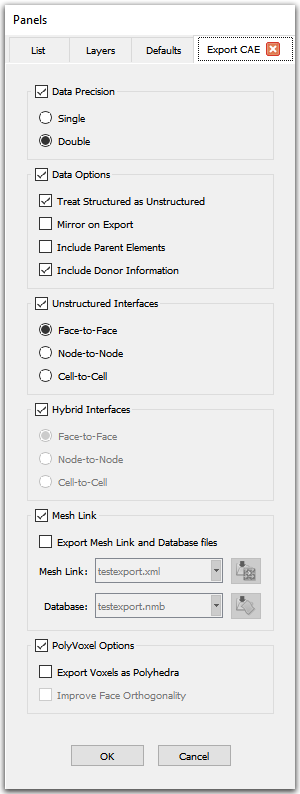Description
CGNS export supports fully structured, fully unstructured, and hybrid volume grid export. Structured blocks can also be exported as an unstructured collection of hexahedra.
Tip: The CGNS format (https://cgns.github.io/cgns-modern.github.io/index.html), a CFD data standard, is really useful for cases where you need to get your grid data into a format you can use for your own in-house solver. Publicly available, this format is supported by many mainstream CFD software packages.
Note: In order to export 2D meshes using the 2D CGNS format, the mesh must be aligned with Z-plane. Meshes that are aligned to the X- or Y-plane or that are non-planar can still be exported using the CGNS format as 3D meshes. In other words, with CAE Dimension set to 2D, constant Z planar grids will be exported with only X and Y coordinates. For all other orientations of planar grids, all three coordinates will be exported.
Blocks are written to separate zones within the exported CGNS file. Each zone is labeled with a "family" name that corresponds to the VC assigned to the block. Family zones are also written per VC and include ID, type, and name. Face-based boundary regions are exported as 2D element zones.

Binary export in Single or Double precision can be used. Double precision is selected by default.
Note: In the Data Options frame, Mirror on Export only appears if a mirror plane has been set prior to exporting the CAE file. You can set the mirror plane using the Set Mirror Plane command.
In the Data Options frame, Treat Structured as Unstructured is used to convert structured blocks into unstructured hexahedra data. This
option is only available (and checked on by default) when structured blocks are selected for
CAE export. Mirror on Export specifies whether or not to mirror all blocks on export.
This option is only available if a mirror
plane has been set prior to CAE export. Include Parent Elements will write elements,
faces in 3D, in Element_t nodes containing additional information specifying the cell ID the elements belong to. When Include Donor
Information is checked on, the donor connectivity is also specified in ZoneGridConnectivity_t nodes. This latter option is required
for cgnscheck (a CGNS file validator) to consider the file to be correct.
Caution: The Include Donor Information option specifies that additional donor connectivity be exported for the nodes at interfaces between blocks. This option only takes effect when exporting multiple blocks (since there is no connectivity when exporting a single block) and can significantly increase the time it takes to export your file. Therefore, it is recommended to use this option only if your solver needs the donor information.
Depending on the current selection, interfacing control is available. The Unstructured Interfaces frame provides options to determine the form in which unstructured blocks will be interfaced to each other. The Hybrid Interfaces frame provides options to determine the form in which unstructured and structured blocks will be interfaced. Hybrid Interfaces options are only available when both unstructured and structured blocks are selected, and the Treat Structured as Unstructured option is unchecked. Similarly, the Unstructured Interfaces options are only available when multiple unstructured blocks are selected for CAE export.
Three interface options are available for both scenarios: Face-to-Face, Node-to-Node, and Cell-to-Cell. Connections are matched by the chosen entity. For example, if Cell-to-Cell is chosen, then every cell on one side of the connection will be matched by cell ID to the cell ID of the adjacent cell on the other side of the connection. Note that no interfacing control is provided for structured to structured block connections. These are always written as structured index ranges with appropriate transformation data.
The Mesh Link frame provides options to indicate whether you wish to write out the Mesh Link and Database files during the export process in *.xml and *.nmb formats respectively. Furthermore, the Database file can be exported in either Binary (default) or ASCII format. For more information on the Mesh Link format and libraries, please visit our GitHub page: https://github.com/pointwise/MeshLink
The Database file contains all the database entities that have grid entities constrained to them. On the other hand, the Mesh Link file contains link information between the grid entities being exported and the database entities in the Database file. Checking on the Export Mesh Link and Database files options will run the Mesh Link process and export these two additional files.
When Export Mesh Link and Database files options is checked on, the Mesh Link and Database file browser buttons become enabled. These buttons will open up a file browser dialog window that will allow you to independently chose the location of the exported Mesh Link and Database files. Note that the text fields for both files are read-only; these fields will be populated with the base name selected for CAE export.
Note: Note that more CGNS solver attributes are available in CAE, Set Solver Attributes.